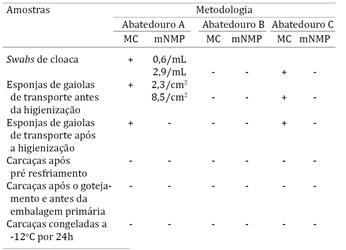Poultry products can be important modes of transmission of Salmonella spp. to humans and, among several parameters used to determine food quality, microbiological characteristics play an essential role. The aim of this study was to determine and quantify Salmonella spp. at broiler slaughtering facilities. This was done by conventional microbiology and by the miniaturized most probable number (mMPN) methods. Three federally-inspected slaughterhouses were visited, where samples were collected in triplicate from six sites: reception of live birds (cloacal swabs and sponge samples from transport cages before and after sanitation) and carcass processing (after pre-chiller, after dripping, and before primary packaging and refrigeration at -12oC for 24h), totaling 108 samples. Three of the six surveyed sites and two of the three slaughterhouses were contaminated with Salmonella spp., showing an infection rate of 5.5% independently of the method used, and revealing that transport cages were contaminated after sanitation. No correlation could be established between the results of conventional microbiology and mMPN methods, and contamination along the slaughtering line could not quantified. This indicates the importance of combining qualitative and quantitative methods for the enumeration of Salmonella when detection rates are lower than the proposed mMPN limit (0.13 MPN/mL). Typhimurium, Panama, Lexington and Rissen, which are paratyphoid organisms and are potentially infectious to humans, were identified. However, these serovars were isolated at the reception of live birds (from cloacal swabs and from transport cages) rather than from the end products. Given that Salmonella spp. was detected in transport cages after sanitation, it is paramount that automated washing procedures currently used in slaughterhouses be reassessed and adjusted.
Salmonella spp.; miniaturized most probable number; serovars; poultry slaughterhouses.

 Thumbnail
Thumbnail


